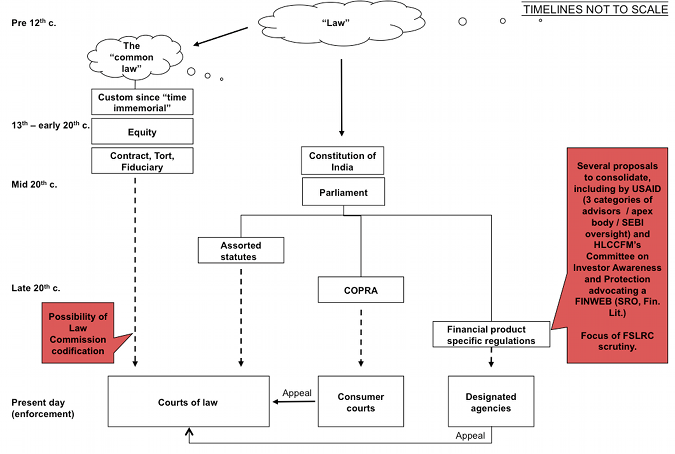In our series of posts on Consumer Protection, this post represents the second part in a two part series that charts out the historical evolution of the various sources of consumers’ rights in India today.
Historical Evolution
As discussed in the first part of this blog entry, it is useful to disaggregate the study of the evolution of the different sources of consumer protection laws into four timeframes:
a. pre – 1950
b. 1950 – 1986
c. 1986
d. 1986 – present
Recent developments occurring in the past twenty five years may now be considered.
1986 – present
Apart from the remedies available through the courts of law and consumer courts, consumer in India of financial products and services may also resort to mechanisms set up by product specific regulators.
Credit
The central bank, the Reserve Bank of India, is also the regulator of the banking system – and consequently oversees the consumer protection regime for credit products in India. The RBI issues guidelines from time to time covering various aspects of consumer protection.
While the RBI was set up in 1934, it has become far more active in protecting the interests of end-consumers primarily in the past two decades – reflecting, in some senses, the creation of the SEBI in 1992 and the IRDA in 1999 to protect the interests of investors and purchasers of insurance products.
The matrix of consumer protection for aggrieved consumers of credit today is as follows:
a. Information dissemination to customers mandated by the Banking Codes and Standards Bureau of India (BCSBI) / Fair Practices Code adopted by banks
b. In-house grievance redressal mechanisms set up by banks
c. Office of the Ombudsman, created by RBI in almost every state of the country, that could enquire into complaints not properly resolved by the concerned bank
Banking Ombudsman Scheme is fully funded and managed by India’s central bank – bank customers can lodge a complaint with any of the 15 offices of the Banking Ombudsman situated across the country, on 27 different grounds of “deficiency in banking services”.
d. Consumer Courts under COPRA
e. Courts of law
The roles and functions of the different institutions overlap at times. Ease of access to these bodies depends on the location and profile of the customer. Further, rules of procedure may stipulate that aggrieved consumers move or consult another forum before approaching that particular body (for ex. the Ombudsman may insist that in-house banking redressal mechanisms be pursued as the forum for first relief).
Securities
Aspects of consumer protection relating to securities in India are regulated by the Securities Exchange Board of India. Set up by an Act of Parliament in 1992, the SEBI was set up “..to protect the interests of investors in securities and to promote the development of, and to regulate, the securities market…”. The SEBI has three functions rolled into one body: quasi-legislative (ie. drafting regulations), quasi-executive (ie. enforcement of applicable rules and regulations to its constituents) and quasi-judicial (conducts hearings and passes orders on various disputes, with in-house appellate forum).
The matrix of consumer protection for aggrieved consumers of securities in order of access is as follows:
a. SCORES
SEBI Complaints Redress System – an online portal for investors to register their complaints against listed companies and intermediaries.
b. SEBI Tribunal
SEBI Tribunal has exclusive jurisdiction in matters falling under the scope of the SEBI Act to the exclusion of courts of law and by extension, consumer courts
c. Securities Appellate Tribunal (SAT)
Forum for first appeal from decisions of the SEBI Tribunal
d. Supreme Court
Second appeal lies directly to the Supreme Court but only on “questions of law”
Various details – primarily procedural but also substantive – as regards the functioning of the SEBI Tribunal as well as the Securities Appellate Tribunal are dealt with by the SEBI Act referred to earlier as well as rules framed thereunder.
Insurance
The insurance sector in India (both life insurance and general) is governed by the Insurance Regulatory and Development Authority, set up by an Act of Parliament in 1999 “…to protect the interests of the holders of insurance policies, to regulate, promote, and ensure orderly growth of the insurance industry…”.
Quasi-legislative powers, in the form of regulation and rule-making authority, are conferred upon the regulator, subject to Parliamentary oversight. The IRDA also passes regulations from time to time regulating both substantive as well as procedural aspects of the above consumer protection structure.
The matrix of consumer protection for aggrieved consumers of insurance in order of access is as follows:
a. Grievance redressal cell within each of the life and non-life companies
Mandated by IRDA (Protection of Policyholders’ Regulations), 2002.
b. IRDA Grievance Cell / Director of Public Grievances (only for public sector insurance companies)
These remain the second port of call, coming into play in practice only after the consumer has sought redress through the in-house grievance cells. The latter, the Director of Public Grievances entertains complaints against the public sector insurance companies (including LIC, GIC, United India, National, New India, Oriental) and is based within the Cabinet Secretariat of the Government of India.
c. Insurance Ombudsman
First created by Government of India notification in 1998. There are 12 such ombudsman in India. Insured is necessarily required to first approach the concerned insurer, failing which he may approach these ombudsman.
d. Consumer courts under COPRA
e. Civil courts
Pensions
The pension sub-sector of the financial products and services sector falls under the regulatory ambit of the Pension Fund Regulatory and Development Authority (PFRDA), established “to promote old age income security by establishing, developing and regulating pension funds, to protect the interests of subscribers to schemes of pension funds and for matters connected therewith or incidental thereto”.
However, from the point of view of consumer protection, uncertainty still pervades this sub-sector as even though the PFRDA was first established through an executive Government of India order dated 10th October, 2003, the PFRDA Bill providing statutory legitimacy to the same has yet to be passed by Parliament. Till date, no consumer grievance redressal mechanism in the pension sphere analogous to those existing in the insurance, credit and securities’ spheres has been set up by the PFRDA, on account of its lack of statutory legitimacy.
Future Outlook
The overall architecture as detailed above stands at a critical juncture. The government of India has recently up set up the Financial Sector Legislative Reforms Commission (FSLRC) to examine, amongst other things, the architecture of the regulatory system governing the financial sector in India. Considering that consumer protection constitutes an integral facet of the laws governing the sector, structural changes to this regime may be expected.



